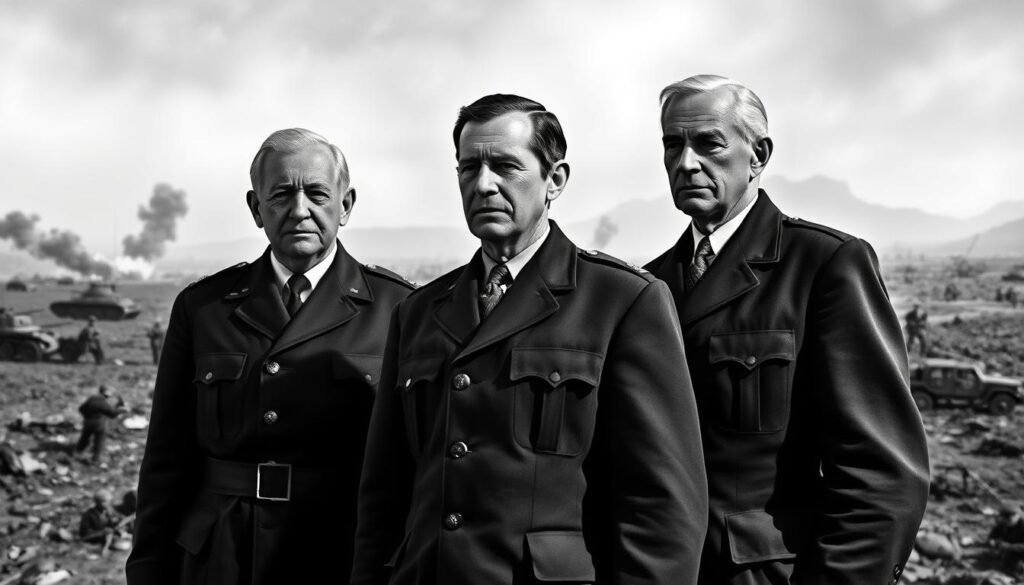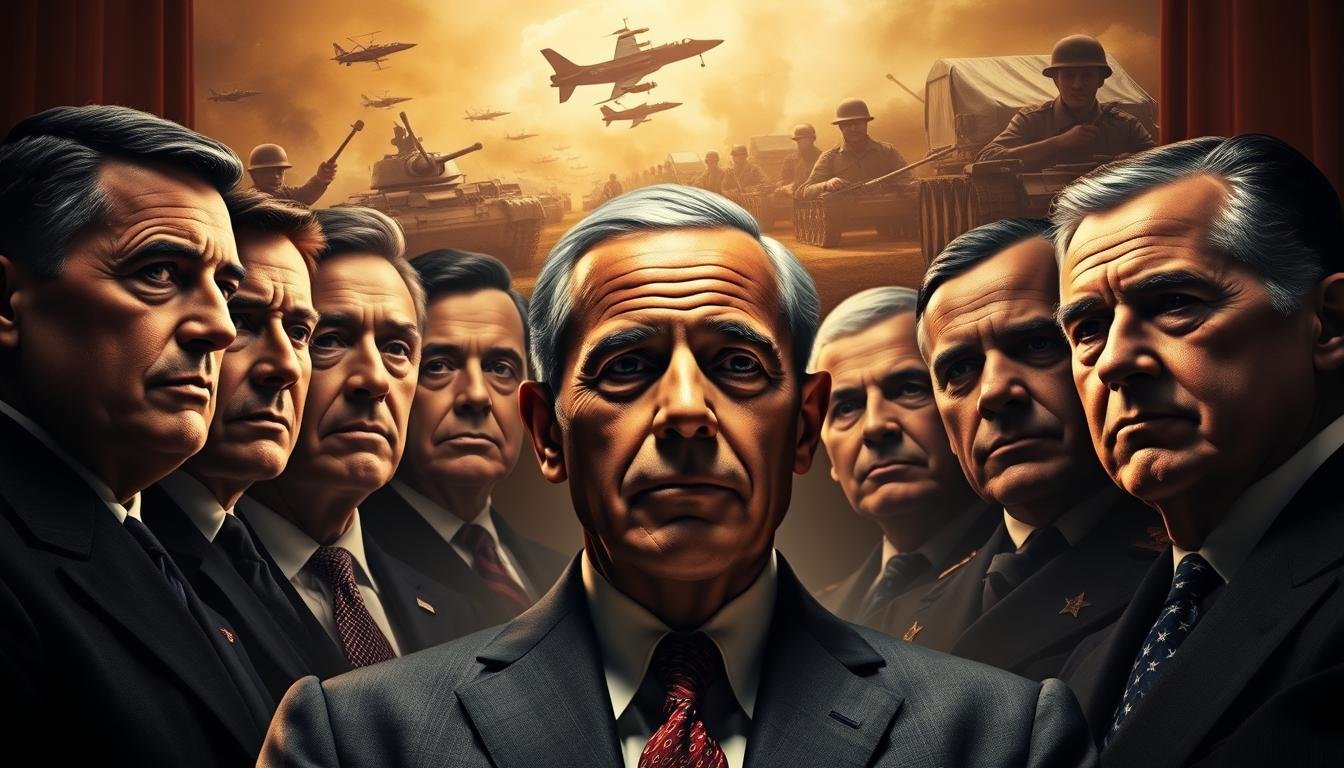US Presidents Who Experienced Both World Wars: Ever wondered about the US leaders who guided the country through two major global conflicts? The US Presidents who were at the helm during World War I and World War II were key figures in shaping history.
These leaders had to tackle huge challenges, from mobilizing troops to making critical decisions. Their experiences and leadership styles offer deep insights into global politics and the duties of the presidency.
Contents
- 1 The Era of Global Conflict: America’s Changing Role
- 2 Which Presidents Served in Both World Wars
- 3 Presidential Leadership Styles During Global Conflict
- 4 From Military Service to the Oval Office
- 5 How World War Experiences Shaped Presidential Policies
- 6 Conclusion: US Presidents Who Experienced Both World Wars
- 7 FAQ
- 7.1 Who were the US Presidents that served during both World Wars?
- 7.2 How did US Presidents’ leadership styles change during global conflicts?
- 7.3 What impact did military service during World Wars have on US Presidents’ policies?
- 7.4 How did the creation of international organizations shape global politics?
- 7.5 What role did US Presidents play in shaping the Cold War?
- 7.6 How did the experiences of US Presidents during World Wars influence their presidential policies?
The Era of Global Conflict: America’s Changing Role
The United States’ entry into both World Wars changed its role in the world. These conflicts led to a big change in how America was seen globally. This change was driven by the need for presidential leadership styles that could handle complex international relations.
During World War I, President Woodrow Wilson’s leadership was key in shaping America’s response. He pushed for the League of Nations, aiming to redefine US foreign policy and work with other countries. But, the US didn’t join the League, showing the ongoing debate between staying out and getting involved.
By World War II, the US took a more active role, thanks to President Franklin D. Roosevelt. His diplomatic work and the US’s entry into the war after Pearl Harbor showed the impact of World War on US policy. The US came out of World War II as a global leader, with its presidents playing a big part in setting up the post-war world.
The two World Wars showed how crucial adaptable and visionary leadership is. As America went through these hard times, its presidents had to balance national interests with working with other countries.
Which Presidents Served in Both World Wars
When you look into the lives of US Presidents, you’ll find two special figures. They served in both World War I and World War II. Their time in these wars greatly shaped their leadership and policies. [US Presidents Who Experienced Both World Wars]
Franklin D. Roosevelt and Harry S. Truman are these two Presidents. Roosevelt was President during the Great Depression and World War II. He was in the US Navy during World War I as the Assistant Secretary of the Navy. His experience in World War I helped him lead during World War II.
Harry S. Truman became President after Roosevelt’s death. He also served in World War I as an artillery officer in France. Later, as President, he made the crucial decision to drop atomic bombs on Hiroshima and Nagasaki during World War II.
These Presidents’ military service and leadership roles gave them a deep understanding of global conflicts. This knowledge influenced their policies and decisions. It helped shape America’s response to the 20th century’s challenges.
Their experiences in both World Wars prepared them for their roles as Presidents. They also left a lasting impact on American history. By studying their service and leadership, we learn about their qualities as effective leaders in times of crisis.
Presidential Leadership Styles During Global Conflict
US Presidents’ leadership during global conflicts greatly impacts the nation’s crisis management. You’ll see various leadership styles when you look at how they make decisions and implement policies.
Some presidents are assertive, relying on their own judgment. Others are collaborative, working with advisors, Congress, and international partners.
| Leadership Style | Characteristics | Example |
|---|---|---|
| Assertive | Decisive, independent decision-making | Franklin D. Roosevelt during WWII |
| Collaborative | Cooperative, consensus-driven | George H.W. Bush during the Gulf War |
The leadership style of a president can greatly affect their wartime policies. By studying these styles, you can understand how leadership shapes the nation’s response to crises.
It’s important to grasp these dynamics. This helps us appreciate the challenges faced by presidents in global conflicts. [US Presidents Who Experienced Both World Wars]
From Military Service to the Oval Office
The journey to the Oval Office often includes significant life experiences, like military service during global conflicts. Many US Presidents have served in both World War I and World War II. They brought unique perspectives to their roles as president.
Dwight D. Eisenhower, for example, was the Supreme Commander of the Allied Forces in World War II. He used his military experience to lead the nation after the war. His leadership and strategic thinking greatly influenced his presidency, especially in international relations and the Cold War.

Other presidents, like Harry S. Truman and Franklin D. Roosevelt, also played key roles in World War II. Truman’s decision to drop the atomic bomb and Roosevelt’s leadership during the Great Depression and World War II shaped their policies.
Exploring these presidents’ lives shows that military service prepared them for the presidency. It taught them duty, leadership, and strategic thinking. These skills were vital for handling global politics during their time in office.
In conclusion, moving from military service to the presidency was more than a role change. It was a continuation of service, leadership, and strategic decision-making. Their experiences in both World Wars greatly influenced their governance and international relations.
How World War Experiences Shaped Presidential Policies
World Wars had a big impact on US Presidents. Their experiences during these times changed their policies. The wars caused a lot of damage and changed how Presidents handled domestic and international issues.
After the World Wars, new international groups were formed. These groups aimed to bring peace and stability worldwide.
The Creation of International Organizations
Right after World War I, the League of Nations was created. It was meant to stop future wars. Even though it failed, it helped start the United Nations.
The UN was formed after World War II. It still helps solve conflicts and keep peace today. [US Presidents Who Experienced Both World Wars]
- The League of Nations was the first global governance structure.
- The United Nations promotes peace and stability.
- Groups like the IMF and World Bank were also set up for global economic stability.
The Cold War and Its Presidential Architects
World War II ended, and the Cold War began. This was a time of tension between the US and the Soviet Union. US Presidents played a big role in the Cold War through their policies.
- President Truman’s decision to drop atomic bombs on Hiroshima and Nagasaki.
- President Reagan’s diplomatic efforts and military buildup.
- The role of presidential diplomacy in ending the Cold War.
US Presidents’ experiences in World Wars influenced their policies. These experiences also shaped the world. Knowing about these impacts helps us understand how US presidential policies have evolved and their lasting effects on international relations.
Conclusion: US Presidents Who Experienced Both World Wars
The US Presidents who served during both World Wars left a lasting impact on American history. Their experiences and leadership styles greatly shaped the country’s response to global conflict. [US Presidents Who Experienced Both World Wars]
These presidents faced many challenges, from mobilizing troops to making key decisions. Their leadership styles were different, but their dedication to the nation was strong.
Learning about these presidents’ wartime experiences helps us understand American foreign policy and the presidency’s role in crises. Their legacies show how their experiences in World War I and II still shape US Presidential leadership today.
See Also: The Reason US Presidents Don’t Wear Wedding Rings
FAQ
Who were the US Presidents that served during both World Wars?
Franklin D. Roosevelt and Harry S. Truman were the US Presidents during both World Wars. Truman was vice president under Roosevelt in World War II’s final stages. Only Roosevelt was president during both wars, serving from 1933 until his death in 1945.
How did US Presidents’ leadership styles change during global conflicts?
US Presidents’ leadership styles changed a lot during global conflicts. They moved towards more centralized decision-making and international cooperation. For example, Roosevelt helped create the United Nations after World War II.
What impact did military service during World Wars have on US Presidents’ policies?
Military service in World Wars deeply influenced US Presidents’ policies. World War I’s trauma led to isolationist policies in the 1920s and 1930s. World War II shaped the post-war world and made the United States a global superpower.
How did the creation of international organizations shape global politics?
The creation of organizations like the United Nations changed global politics. Countries started working together to solve common problems. These organizations help with cooperation, preventing conflicts, and tackling issues like human rights and climate change.
What role did US Presidents play in shaping the Cold War?
US Presidents were key in shaping the Cold War. Leaders like Truman, Eisenhower, and Kennedy made important decisions. The Cold War was a long period of tension between the United States and the Soviet Union, with US Presidents playing a crucial role.
How did the experiences of US Presidents during World Wars influence their presidential policies?
World War experiences shaped US Presidents’ policies. Roosevelt’s World War II experience influenced his vision for the post-war world. Truman’s decision to drop atomic bombs on Hiroshima and Nagasaki was a turning point in warfare.

Hi, I am Tatum Bradford from Washington. I have a background in political science and work as a senior revenue officer. I love learning about U.S. presidents and sharing interesting facts about political history.

